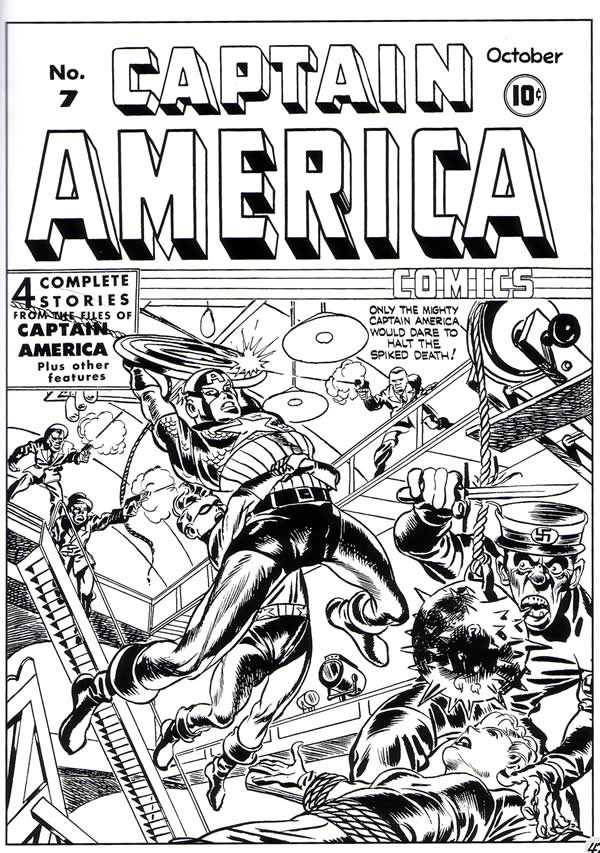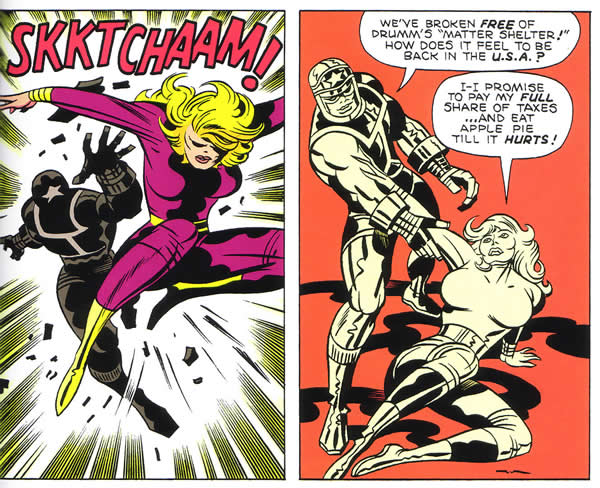Whenever the art of Jack Kirby is discussed, someone will inevitably mention that sometime during the mid to late seventies, his artistic abilities went into steady decline, continuing until his death. It is reasonable to have this opinion and one can certainly point to examples of Kirby’s later art that don’t seem to compare favorably to the work of his prime. I contend however that much of his later work, such as the Silver Star miniseries is infused with an energy and a perspective that more than compensates for any perceived deterioration of artistic technique.
First, let us view an early example of Kirby’s work from the Simon and Kirby run of Captain America, the cover of issue #7. I chose this particular cover because it contains a variation of a pose that Kirby would revisit throughout his career. Cap is swinging across the length of a large space, with his pelvis thrust fore ward and his torso arched. His arms are stretching back holding a rope and his legs are also bent backward to accentuate the arch.
Something very similar to this pose occurs nearly twenty five years later, appearing in Marvel Comics Captain America #103. Note that in the first example, Kirby’s rendering of Cap’s physique is probably one of the closest to an anatomically correct figure that he will ever draw. Cap’s quadriceps muscles for example are more or less where they should be. In the later example, Kirby is drawing far more expressionistically.
Rather than employing literal renderings of specific muscles, Kirby uses powerful pencil slashes that suggest force and strength. Many Kirby aficionados consider this period to be the height of his creative powers. Kirby would continue in this direction, moving further into the area of abstraction. He would seemingly grow less concerned with the depiction of actual reality and focus on storytelling and raw energy. That pose turns up again in issue #2 of Silver Star and here, Kirby seems even less concerned with anatomical correctness while focusing on the force of the movement.
This particular comic from the 80’s may appear uneven at first glance, but it’s full of extraordinary moments of unleashed Kirby energy. The King is moving at breakneck speed here, and seems unfettered by any constraints, either artistic or literary. He is still using special arrangement masterfully, in terms of his visual cues, but his style has become even looser and more expressionistic.
This page is very close to Kirby at his prime. There is little indication of any loss of ability, but there are instances throughout the book where Kirby’s spatial perception feels a bit skewed.
If we look at the face and figure of Norma in this lower right panel it certainly could be said to be distorted. It is if Kirby is no longer concerned with conventional anatomy at all. He has moved into abstract expressionism full speed ahead. As his character Galactus does, Kirby has miraculously converted everything into pure energy.
Other pages are thoroughly splendid examples of Kirby still apparently at his peak in page composition. His sense of deep space is sometimes cramped and in many cases he dispenses with backgrounds entirely, but the movement is explosive and the continuity is superb. This page below has a wonderful elastic quality about it. It is almost as if Kirby is reverting to his training with the Max Fleischer animation studio.
This page in particular made me realize that I was essentially judging Kirby’s later work by my own obsession with his earlier efforts. 1960’s Kirby had been such a strong influence on my formative years, that any deviation from the familiar seemed to me to be a letdown. Even the gradual movement towards abstraction of his seventies art was a shock. This Silver Star page, with its extraordinarily flexible action figures forced me to view its innovation with a fresh perspective.
Putting the art work aside for a moment, let us discuss the nature of the plot behind this series. The story begins with the entrance of an entrancing girl named Tracy, who sings and cavorts with the hero in a fantasy landscape. In fact, the world is an elaborate construction by Silver Star, who is capable of manipulating the atomic structure of reality. Sadly, the girl is trapped in stasis, a sort of limbo.
The character of Tracy is quickly abandoned, as the story races towards a conclusion of wholesale riot and mayhem. The culmination is the appearance of the Angel of Death. This story feels to me as if it is very personal to Kirby. It is imbued with a great deal of passion and reflection on the state of society.
Silver Star is a reflection on the Vietnam debacle, but it appears in the early eighties. This is the post-punk landscape, and Vietnam is viewed from the new wave perspective, as it was in such films as Apocalypse Now and the Deer Hunter. Silver Star even makes what could be taken as an oblique reference to a sequence in the latter film by stating that, ‘this same guy was around in Vietnam, ‘playing Russian Roulette with our lives’.
Is Kirby at age sixty five sensing his own mortality as he serves up this horrific nightmare vision of impending doom? Seldom before has the artist so completely depicted such appalling and unrelenting carnage. Kirby’s finale is an inferno of biblical proportions as the flame breathing airborne demon scorches the earth.
The visual storyteller deals with the dreams and fantasies of the collective unconscious. Thus, Kirby’s hand is a conduit, directly from his subconscious to the page and the horrors that he draws here feel as though they are things that the artist has actually witnessed.
This is the battle scarred inner landscape of someone who has seen war at first hand. There appears to be little room for hope in this scenario, and we as readers and spectators cannot avert our eyes from the horror. Yet, somehow Kirby turns away from the abyss before all is lost. The Dark Angel cannot fulfill his mission of destruction. He sees his own face in the multitudes that he seeks to destroy, due to an illusion caused by Silver Star.
In the words of Kirby scholar, Greg Theakson, Kirby is, “Scrapper who can wrestle against all odds, angel of death included.” The apocalypse is averted this time. Silver Star levitates, rising like one resurrected. As he poses like Christ with his arms outstretched, he asks the question, “Can a man survive himself?”
In terms of artistic greatness, Kirby has certainly done so.
1 – Captain America#7, cover. Art, Jack Kirby, from “The Comic Book Makers”, Joe Simon and Jim Simon
2 – Captain America #103 pencils, Jack Kirby, dialog Stan Lee, Jack Kirby Collector #7
3 – Silver Star #2 Jack Kirby art and story, Silver Star Volume #1 Image Comics
4 – Silver Star #6 Jack Kirby art and story, Silver Star Volume #1 Image Comics
5 – Silver Star #5 Jack Kirby art and story, Ibid
6 – Silver Star #6 cover, Ibid








I love Kirby.
I love all of his stuff.
That being said that a lot of the distortion in the art at the end seems to be more a symptom of his failing eye sight and unique drawing ability. The way he would almost project his drawing and then trace that image on the boards instead of usual roughing in that most other artists do(myself included).
I think had his eye sight not failed we would still get that great expressionism he had but without the off center faces and whatnot. -Mike Moran http://kirbytothdude.blogspot.com
The spirit is willing , but the flesh is weak
Mike, you are correct.
Until the end, Kirby showed he still had the fire but its body failed him and it was probably more frustrating for the man than is was for us (his fans).
I, TOO, LOVE THE KING !
Kirby was king. All things pass, even personal peaks. His work in the 1960’s happened, and we are the better for that.
In the better late than never category, Norris, I greatly enjoyed your examination and commentary on Silver Star. Jack did a great job on this even though he was going through his various medical trials and tribulations, and I think Silver Star is an underrated Kirby creation that deserves more exposure so those readers who might have missed it on the first go round can pick up on it.